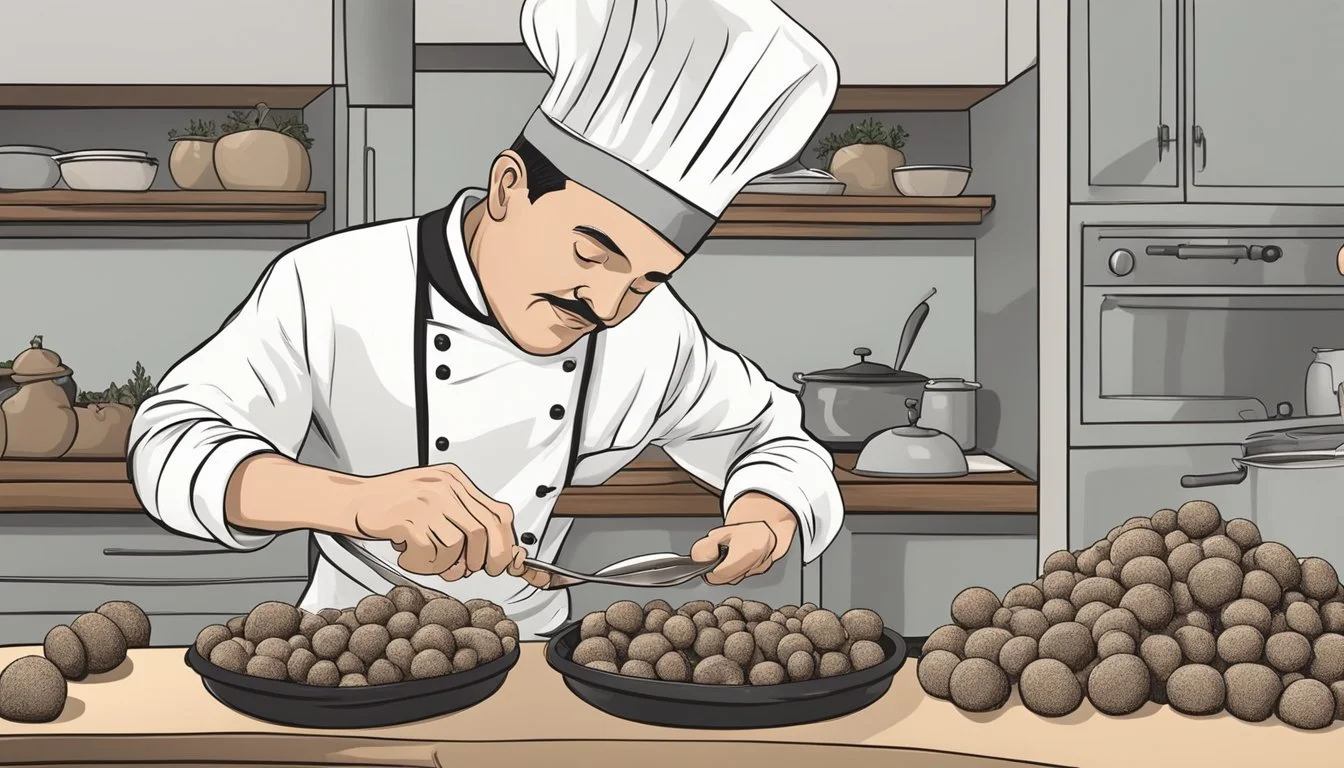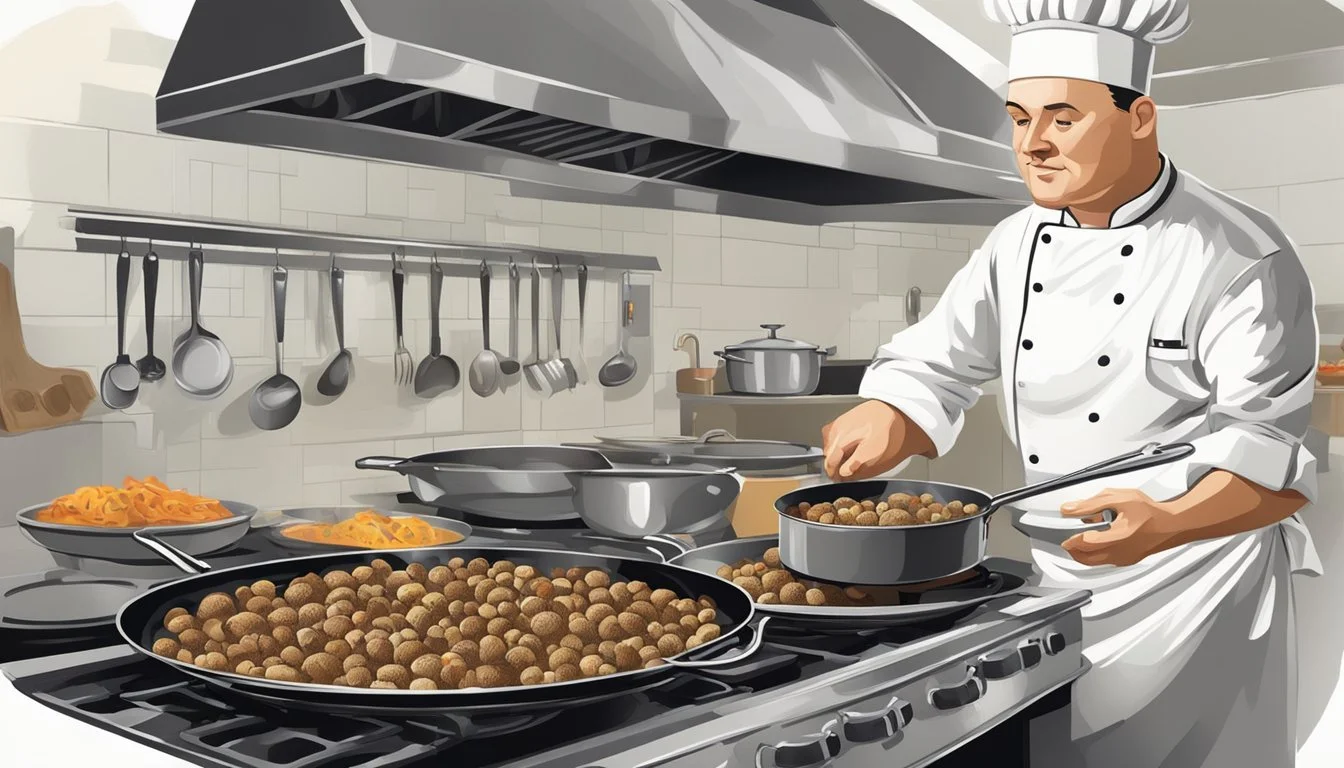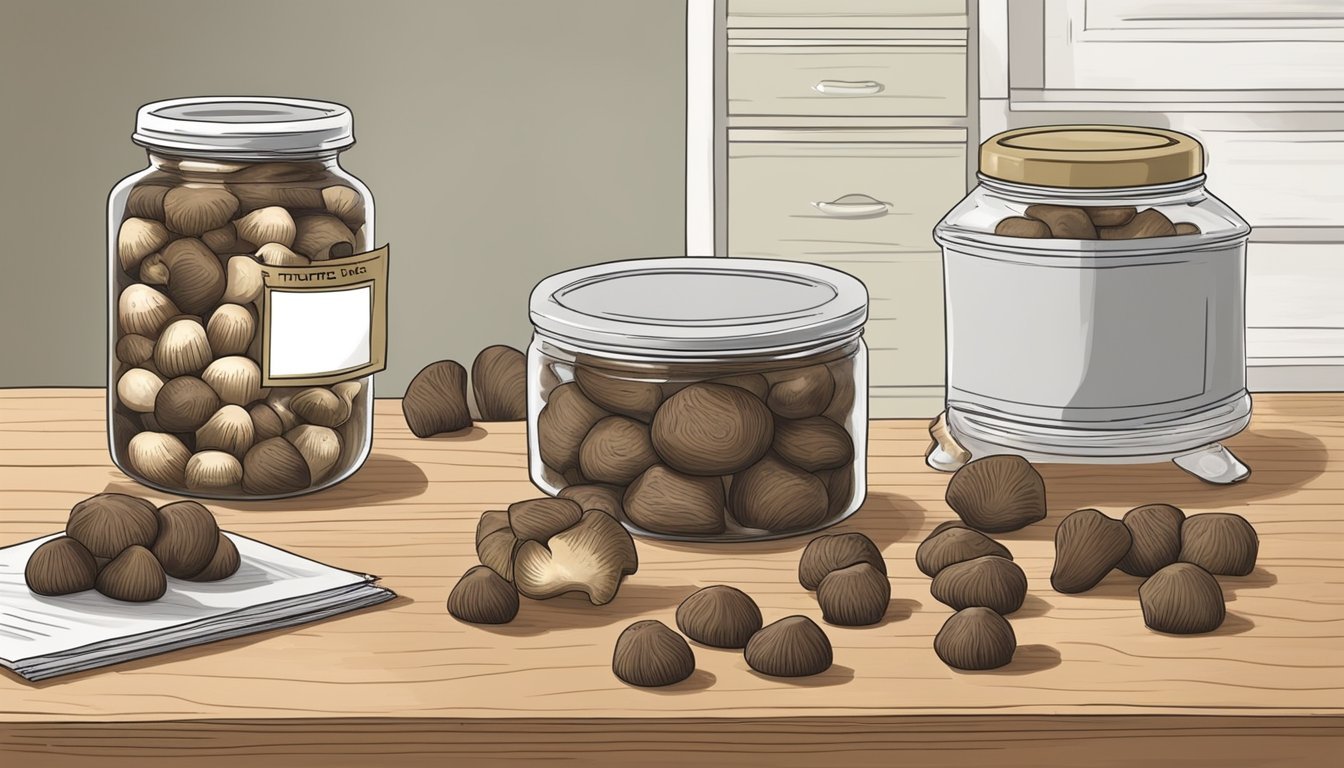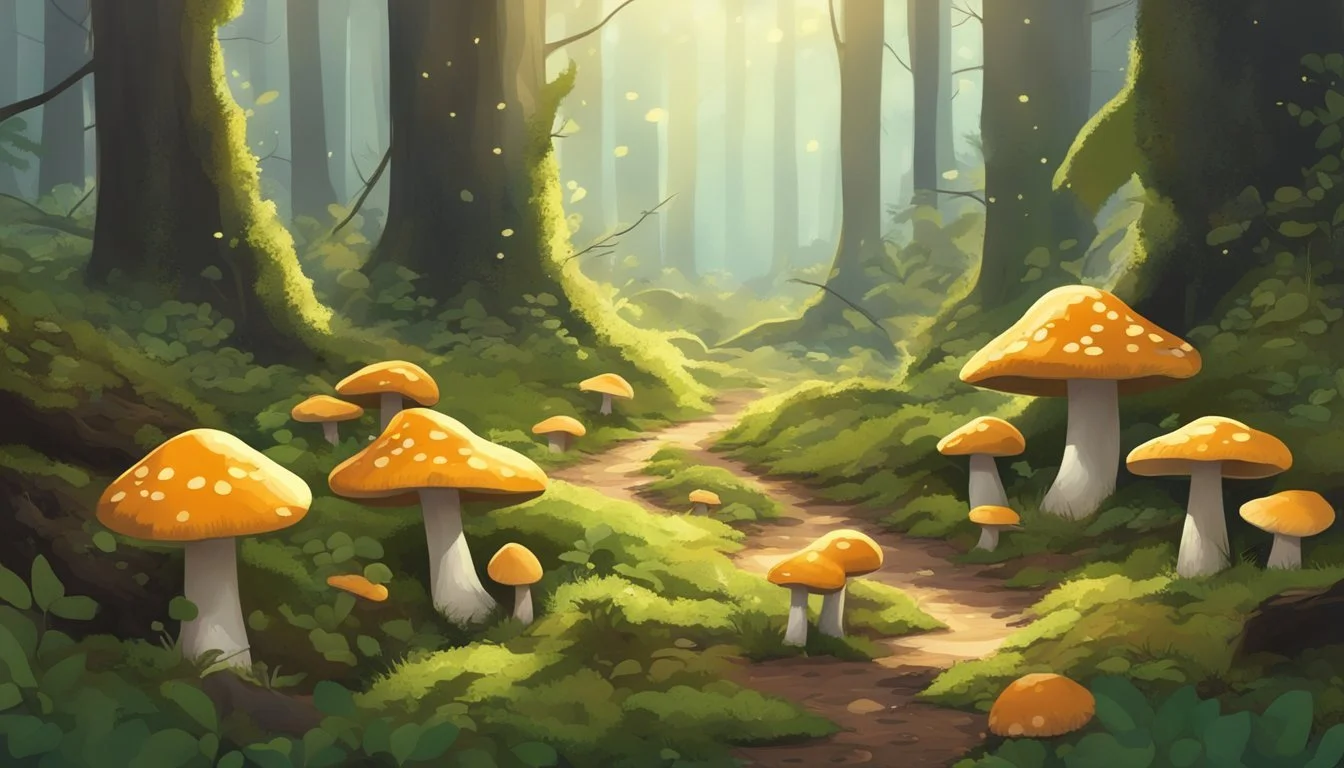How to Substitute Truffles for Mushrooms in Your Recipes for Enhanced Flavor
Truffles have long held an esteemed status in the culinary world, revered for their distinctive aroma and rich flavor that can elevate the most basic dish into a gourmet experience. However, their scarcity and the labor-intensive process of foraging them contribute to a steep price tag that is not always accessible. Fortunately, the culinary landscape offers mushrooms (What wine goes well with mushrooms?) that, while not identical, can serve as commendable substitutes for truffles, providing a similar depth and earthiness to dishes.
Mushrooms are a versatile ingredient, and certain varieties, like the black trumpet mushroom, offer truffle-like qualities that can mimic the flavor profile of the more expensive fungi. Known colloquially as “the poor man’s truffle,” the black trumpet has a potent taste with subtle nuances reminiscent of truffles, which can be especially effective when used in recipes that call for the expensive delicacy. While the texture and intensity may vary, these mushrooms can be incorporated into recipes through simple techniques like infusing them into oils or folding them into butters, thereby imbuing the dish with a comparable umami character.
Understanding Truffles and Mushrooms
Before diving into the specifics, it is essential to grasp the fundamental differences and similarities between truffles and mushrooms, which are both fungi celebrated for their distinctive flavors and culinary applications.
Classification and Characteristics
Truffles and mushrooms belong to the Kingdom Fungi, but they differ significantly in their growth and morphology. Mushrooms tend to grow above ground and feature a stem, cap, and gills. Truffles, on the other hand, grow underground and do not have a typical mushroom structure, being mostly spherical and lacking a stem and visible spores.
Flavor Profiles
The flavors of truffles and mushrooms can be described as earthy and umami-rich. They are prized for their depth of flavor in a range of culinary dishes. While mushrooms have a savory profile that can complement a wide array of ingredients, truffles have a more intense and distinctive taste that is often considered luxurious and unique.
Aroma and Taste
Truffles are renowned for their pungent aroma, which is rich and earthy with hints of nuttiness and chocolate. Their taste is also distinctively potent. Mushrooms, while still aromatic, offer a more subtle fragrance and taste, with certain varieties carrying a mild umami flavor that enhances their versatility in cooking.
Varieties of Truffles
There are several types of truffles, some of the more prized varieties include:
White Truffles: Found primarily in Italy, they are highly sought after for their strong, aromatic qualities.
Black Truffles: Sourced from regions like France, they are less intense than white truffles but still highly valued.
Each truffle variety brings its unique flavors and aromas to a dish, contributing to its overall gastronomic experience.
Economic Factors of Substitution
When considering truffle substitutes, one must examine the economic implications. The primary motivators for substitution often revolve around cost and availability, as truffles are known for their luxury status and high price tag.
Comparing Costs
Truffles: A luxury ingredient, they can command prices up to £1,000 per pound for premium varieties.
White Truffles: Often more expensive than black truffles due to their intense aroma and flavor.
Black Truffles: Slightly more affordable but still expensive. They carry a robust, earthy flavor profile.
Mushroom Substitutes:
Mushrooms: Common varieties like cremini or portobello offer a cost-effective alternative, often below £5 per pound.
Truffle Oils: Typically use a base of olive oil infused with truffle essence, providing a budget-friendly option with a truffle-like flavor. Price ranges vary, but they are significantly less expensive than whole truffles.
Dried Porcini Mushrooms: Known for their savory depth, available at a fraction of the cost of real truffles.
It is clear from a price standpoint that substituting mushrooms for truffles can lead to substantial savings.
Market Availability
Truffles:
Availability is seasonal and regional; hence, they command a high market price.
Fresh truffles may be scarce in markets, dependent on the season and region.
Mushroom Substitutes:
Widely available year-round in most supermarkets and specialty stores.
No significant scarcity issues, making them a reliable and accessible option.
The market availability of mushroom substitutes makes them a pragmatic choice for both consumers and chefs looking for truffle flavors without the luxury cost.
Culinary Uses and Substitution Techniques
Truffles impart unique flavors and are a coveted ingredient among chefs for adding depth to dishes such as pasta and risotto. The following subsections provide techniques to incorporate truffles or their substitutes effectively in culinary applications.
Incorporating Truffles in Dishes
The use of truffles in the culinary world is esteemed for their distinctive umami and earthy flavors. Chefs often shave them thinly atop finished dishes to preserve their volatile aroma. Truffle oil serves as a more accessible alternative, ideally used sparingly as a finishing touch to maintain its integrity. It pairs excellently with simple pasta dishes where the truffle's flavor can stand out.
Recipe Adaptations for Substitutes
Due to their cost, finding a substitute for truffles that offers a similar complexity becomes necessary. While no substitute perfectly replicates the unique flavor of truffles, many ingredients can mimic aspects of their profile:
Garlic and Butter: This combination can add a rich and aromatic quality to sauces and oils that echo the garlicky notes of white truffles.
Mushrooms: Certain varieties such as the black trumpet possess truffle-like qualities and can be used in a finely chopped or ground form to infuse dishes with an earthy component.
Matching Textures and Flavors
The success of a truffle substitute not only relies on mimicking the flavor but also the texture. When using mushrooms as a truffle alternative:
Maintain a fine chop or blend mushrooms to achieve a texture that complements the dish without becoming overpowering.
Supplement with umami-rich ingredients such as soy sauce or Parmesan cheese to enhance the mushroom's natural umami elements.
By considering the role truffles play in a dish, chefs can select appropriate substitutes that provide a similar sensory experience. Whether it's the scent profile imparted by truffle oil in a buttery pasta or the savory depth contributed by mushrooms in a rich risotto, the goal is to maintain the essence of the dish with thoughtful substitutions.
Selecting and Preparing Truffle Substitutes
Truffle substitutes can bring a similar depth of flavor to various dishes if selected and prepared thoughtfully. This section outlines the process of choosing suitable mushroom alternatives, proper handling and storage, and the cooking techniques to best capture truffle-like qualities.
Choosing the Right Mushroom Variants
When looking for a truffle substitute, quality and flavor profile are key. Black trumpet mushrooms are often hailed as a "poor man's truffle" due to their potent aroma and truffle-like flavor nuances. For a more nuanced, earthy flavor, one might consider porcini mushrooms, known for their rich taste and meaty texture. Select mushrooms that are firm, free of blemishes, and have a pleasant, earthy scent to ensure the best result.
Handling and Storage
To maintain quality and moisture, mushrooms should be stored properly. For fresh mushrooms like porcini and black trumpets:
Storage: Keep them in a paper bag in the refrigerator to allow airflow and reduce moisture buildup.
Handling: Clean gently with a brush or a damp cloth; avoid soaking as they can become waterlogged, diluting their flavor.
For dried mushrooms:
Rehydrate them in warm water for about 20 to 30 minutes before use, and remember to save the flavorful soaking liquid for cooking.
Cooking Methods for Optimal Flavor
Proper cooking methods can significantly enhance the truffle-like quality of substitutes. Here are some recommended preparations:
Sautéed: Quick sautéing in butter or oil preserves the mushrooms' inherent flavors and texture.
Baked: Gentle baking in a dish can concentrate the flavors and replicate the truffle essence.
Fried: For a crispy edge and tender center, frying in a light oil can add another layer of taste and texture.
Avoid serving these mushroom substitutes raw, as cooking unlocks their full aromatic potential.
Practical Tips for Cooking with Truffle Substitutes
When seeking to replicate the unique flavor of truffles in cooking, choosing the right substitutes and understanding how to use them is crucial. Careful selection and application can achieve a robust, earthy component reminiscent of truffles in various dishes.
Enhancing Dishes with Substitutes
Mushrooms: Chefs often use black trumpet mushrooms as a truffle stand-in due to their rich and earthy flavor profile. They should be chopped finely and added to sauces, risottos, or pasta to impart a dense, moist quality that echoes the intensity of truffles. Here’s how to make the most of mushroom substitutes:
Fat: Cook mushrooms in butter or oil to bring out a nutty flavor.
Seasoning: Balance their taste with a pinch of salt but mind the sodium; truffles and their substitutes are inherently savory.
Application: Incorporate mushrooms at the end of the cooking process to avoid loss of flavor.
Using Truffle-Infused Products
Truffle Oil: A few drops of truffle oil as a garnish on completed dishes can provide a sweet, garlicky note. This should be used sparingly since the oil's intense aroma can overwhelm other flavors. Truffle Salt is an alternative that combines sea salt with truffle essence, useful as a finishing touch to impart complexity.
Cheese: Parmesan cheese is another product that exhibits truffle-friendly flavors. When grated over warm dishes, its rich profile melds with the truffle substitute to create depth.
Using truffle-infused products is about highlighting, not dominating, the dish’s natural flavors. Here are specific tips:
Amount: Just a few drops or a light sprinkle of these products can suffice.
Pairing: Combine with ingredients that complement rather than compete with the truffle-like aromatics.
Temperature: Add to warm dishes to help release the fuller spectrum of scents and tastes.
Preservation and Shelf Life Considerations
The preservation of truffles, when used as a substitute for mushrooms, hinges on maintaining their distinct aroma and flavor while extending their practical shelf life through proper storage methods.
Maintaining Quality and Freshness
To preserve quality and freshness, truffles should be stored in an airtight container to protect them from moisture and other contaminants. This also helps to retain their potent flavors. Wrapping them tightly in plastic wrap or aluminum foil before placing them in the container minimizes exposure to air. Refrigeration is necessary to prolong freshness, with truffles ideally kept at or below 40 degrees Fahrenheit. The storage environment should not fluctuate in temperature as consistency is key to maintaining quality.
It’s important to note that companion ingredients stored with truffles, such as potatoes, cheese, or eggs, can absorb their fragrance, thus indirectly preserving the truffle's essence even after its prime. These ingredients can benefit from the truffle's aroma, enhancing their own flavors.
Extending Usability of Substitutes
Increasing the shelf life of truffle substitutes such as mushrooms involves refrigeration or freezing. When freezing, one should remove as much air as possible to avoid freezer burn. It is recommended to use the truffles within six months of freezing to ensure the best texture and flavor.
For those who use truffles as a luxurious complement to proteins, such as in sauces or butters, the processed form can be refrigerated. For instance, truffle-infused sauces can be kept in a refrigerated jar, and truffle butter mixed with softened butter and a pinch of salt can last for up to two weeks in the fridge. This method aids the extension of usability, provides convenience, and ensures the truffle flavor is readily available for enhancing proteins and other dishes.
Understanding Truffle Products
In the realm of culinary luxuries, truffle products hold a prestigious spot. The market offers a variety of items meant to impart the distinctive truffle flavor, but understanding the nuances of these products is essential for making informed choices.
Identifying Authenticity
When selecting real truffle products, it's crucial to scrutinize labeling. Authentic truffle oils, truffle salts, and truffle-infused items should list real truffles as an ingredient. Typically, black truffles (Tuber melanosporum) and white truffles (Tuber magnatum) are used for their pungent aromas and flavors. Black truffles, harvested mainly in winter, exhibit earthy and chocolaty notes, while white truffles, prized for their fall season, deliver a delicate garlicky and peppery taste.
Cultivation methods also affect authenticity. Unlike mushrooms that grow above ground, truffles require symbiotic relationships with certain tree roots and grow underground, making them difficult to cultivate and find. This complexity contributes to their prestige and price.
Type of Truffle Product Identifiers of Authenticity Truffle Oil Contains pieces of actual truffle Truffle Salt Real truffle should be visible Fresh Truffles Sold by weight, seasonally available
Truffle-Infused Alternatives
Truffle-infused alternatives offer a cost-effective way to enjoy truffle flavors without the expense of fresh truffles. Truffle oil and truffle salt are the most common ways to add a truffle essence to dishes. They should be used sparingly to finish or enhance a recipe, as their flavors are potent.
Truffle oil, especially, is a potent condiment made by infusing a base oil with truffle aroma. Its use should be reserved for finishing dishes to retain the volatile compounds responsible for the truffle's signature taste and fragrance.
Truffle salts combine sea salt with small fragments of truffle, providing a more muted but still distinctive truffle flavor. They work well sprinkled on eggs, pastas, or even popcorn, offering an umami quality that complements a variety of foods.
Infused Product How to Use Tips for Use Truffle Oil Drizzling on dishes as a finishing oil A few drops go a long way Truffle Salt Seasoning to elevate flavors Best on simple, mild dishes to stand out
Identifying authentic truffle products and understanding how to use truffle-infused alternatives can greatly enhance a culinary experience, bringing a touch of luxury to the everyday kitchen.
Ethical and Ecological Considerations
When substituting truffles with mushrooms, it is crucial to consider both ethical foraging practices and the potential impact on ecosystems. These considerations are of particular importance due to the rarity and ecological sensitivity of truffles and various wild mushrooms.
Sustainable Foraging Practices
Foragers must ensure sustainability when harvesting wild mushrooms to serve as truffle substitutes. This includes:
Abiding by local foraging laws and regulations.
Harvesting in a manner that allows for replenishment, such as leaving a portion of the mycelium intact.
Avoiding areas where mushroom populations are already under stress.
Utilizing trained dogs or pigs, which are traditional in truffle foraging, to minimize damage to the environment.
Impact on Ecosystems
The collection of wild mushrooms needs to take into account their roles within the ecosystem, as they can be integral to soil health and forest vitality. Critical points include:
Recognizing that some mushrooms form symbiotic relationships with plants. Excessive harvesting can disrupt these relationships, potentially harming both the fungi and the host plants.
Being aware of the presence of rare or potentially poisonous species to ensure personal safety and the preservation of biodiversity.
Acknowledging the difficulty of differentiating between species, which necessitates a high level of knowledge to avoid ecological disturbance.
Seasonal and Geographical Impact
Understanding the seasonal and geographical factors is essential for successfully substituting truffles with mushrooms. These aspects directly influence the availability and flavor profile of mushrooms used as truffle substitutes.
Peak Harvest Times
Truffles: The peak season for truffles varies by type. For instance, the renowned black truffle flourishes in winter, while its counterpart, the white truffle, is typically harvested in the fall.
Mushrooms: Conversely, mushrooms like the yellowfoot chanterelle have their own specific peak times. Yellowfoot chanterelles are commonly foraged in the fall and winter months, aligning closely with the harvest times of certain truffles, which can be favorable for substitution in terms of fresh availability.
Regional Truffle Varieties
Climate and Location: The climate and location play a pivotal role in determining the types of truffles and mushrooms that can be found. For example, European regions such as France and Italy are famed for their high-quality white and black truffles. Conversely, North American truffles exhibit different characteristics due to the distinct climates and soils of the continent.
Mushroom Substitutes: In terms of mushroom substitutes, black trumpet mushrooms are often harvested in wooded areas of Europe and North America and are praised for their delicate and savory spices flavor. They serve as a suitable truffle alternative, especially where climate and soil composition limit the growth of traditional truffles.









